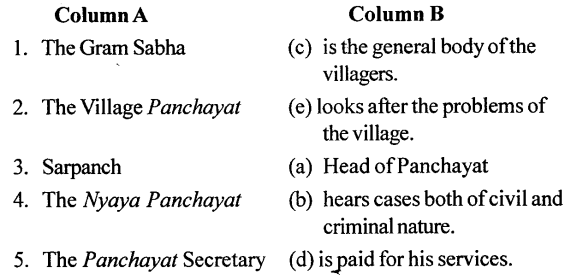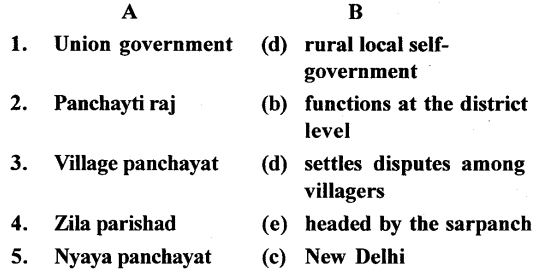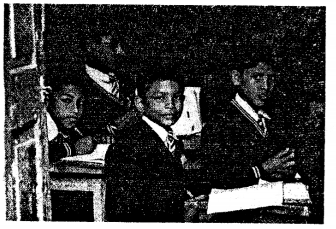ICSE Solutions for Class 6 History and Civics – Rural Local Self-Government
ICSE SolutionsSelina ICSE SolutionsML Aggarwal Solutions
APlusTopper.com provides step by step solutions for ICSE Solutions for Class 6 History and Civics Chapter 1 Rural Local Self-Government . You can download the History and Civics ICSE Solutions for Class 6 with Free PDF download option. History and Civics for Class 6 ICSE Solutions all questions are solved and explained by expert teachers as per ICSE board guidelines.
ICSE Solutions Class 6 History & Civics Geography Biology Chemistry Physics Maths
Exercise
I. Fill in the blanks:
- The Panchayati Raj is a three-tier system
- Panchayat means a team of five members.
- All the adults of a village constitute Gram Sabha.
- Nyaya Panchayat can fine the guilty.
- Village Panchayats teach the first lesson of democracy.
- The term of the Block Samiti is five years.
- The Lok Sabha and Rajya Sabha members chosen from district are also the members of Block Samiti.
- The Zila Parishad is the highest institution of the Panchayati Raj in India.
- The Zila Parishad coordinates the working of the Block Samiti.
- The state government appoints a secretary to maintain the accounts and keep records of the work done by the institutions of Panchayati Raj.
II. Match Column A with Column B:

Answer:

III. State whether the following statements are True or False.
- All people of any age are members of the Gram Sabha.
False. - Women have been given representation in the Panchayat.
True - The members of Gram Panchayat vary from state to state.
True - The first level of local self-government in rural areas is the Panchayat Samiti.
False. - The Nyaya Panchayat can impose fines.
True - The members of the Block Samiti are elected for a period of four years.
False - Zila Parishad works at the village level.
False - The chairpersons of the Block Samitis become the members of Zila Parishad.
True - The Zila Parishad has the responsibility of implementing the development programmes in the district.
True
- The state government gives financial grants to the Panchayats.
True
IV. Answer the following questions:
Question 1.
What do you mean by ‘Panchayat’ ?
Answer:
The word Panchayat literally means a team of five members.
Question 2.
How do Panchayats help villagers ?
Answer:
A Panchyat solves local problems. It gives training to people in functioning of democracy. The villagers sit together and cooperate in Village welfare works. They also develop administrative and management skills. The people also learn to use their own resources for collective welfare.
Question 3.
What are the advantages of Village Panchayats ?
Answer:
There are many advantages of Village Panchayat as there are some basic requirements for a healthy living, such as clean drinking water, cleaning and lighting of roads, medical facilities, primary education for children, roads for transport, etc. Village Panchayats provide for these requirements. Since villagers are more aware of their local problems, the Village Panchayats are a good solution to these problems.
Question 4.
Explain the importance of local self-government ?
Answer:
For development of a community, participation of the local people is very important. Local people know their problems and they understand the needs of their community or locality. When the people of a locality get together to solve their day-to-day problems and fulfill their needs, the government established for the same is called local self-government. Local self-governing bodies develop local leadership that later helps the state and central governments in sharing the burden of work which thus gets done quicker, better and cheaper.
Question 5.
Name the three institutions of the Panchayati Raj. At what levels do they work ?
Answer:
- At the lowest level are the Village Panchayats.
- At the block level it has Panchayat Samiti.
- At the district level is the Zila Parishad.
Question 6.
Explain briefly the composition and functions of a Block Samiti ?
Answer:
Composition of a Block Samiti — The Pradhans and Panchas of the Village Panchayats in a block choose their representatives to the Block Samiti. Besides such representatives, there are other members as well. The members elect a chairperson and vicechairperson. The chairperson looks after everyday’s work of the Block Samiti.
The term of a Block Samiti is five years. Functions of a Block Samiti
- A Block Samiti supervises the working of the Village Panchayats.
- It engages many experts to help the villagers. The experts in the field of agriculture also help the villagers in obtaining better quality seeds, fertilisers, insecticides and in improving the breed of cattle.
- The other experts bring about a change in the outlook of the people through education and literacy.
- It arranges funds from the government for the block development programmes.
- It arranges for expert advice, service to the panchayats for their development in agriculture, construction of roads and buildings, health and education, etc.
Question 7.
How is the Zila Parishad formed ? What are its main functions ?
Answer:
The Zila Parishad is formed by the Chairmen of all Block Samitis in a district, members of Lok Sabha and Rajya Sabha from the district, members of Vidhan Sabha and Vidhan Parishad from the district and representatives of SC, ST and women.
Functions of Zila Parishad
- The main function of the Zila Parishad is to work for the Village Panchayats and Block Samitis.
- The Zila Parishad has also the responsibility of implementing the programmes coming under the Five Year Plan.
- The Zila Parishad also prepares plans for the district.
Question 8.
What has the Panchayati Raj done so far for the rural areas?
Answer:
- The Panchayati Raj has brought political awareness among rural people. They elect and select the Panchayat members and also take part in decision making.
- The Panchayati Raj has improved the conditions of the villages through welfare activities.
- Panchayats have been able to draw the attention of the government officials to their problems.
Question 9.
Discuss the relationship between the state government and the Panchayati Raj ?
Answer:
The state government gives financial grants to the Panchayats. The state government keeps a strict watch on the working of the Panchayati Raj institutions and appoints a secretary to maintain accounts and keep records. The Collector (District Magistrate) or the Deputy Commissioner represents the state government at the district level. He coordinates the work of the government officers of the district and the Panchayati Raj. The Block Development Officer (BDO) does the same work at the block level
Textbook Keywords
- Panchayati raj system: It is the system under which the local self-government at the village level functions.
- Gram sabha: It consist of all the adult members of the village.
- Gram panchayat: It consist of a number of senior members of the village elected by the gram sabha.
- Nyaya panchayat: It consist of elected members who settle disputes among village people.
- Pradhan: He is the heat of the gram panchayat.
- Up-Pradhan: He is the vice-sarpanch of the panchayat who takes over the responsibilities of the sarpanch in his/her absence.
Additional Questions
A. Fill in the blanks:
- The Indian government function at the central, state government and local self government levels.
- The union government deals with matters of national importance.
- All Adult members of the village are members of the gram sabha.
- The nyaya panchayat cannot sent people to Jail.
- The gram panchayat makes the villagers more responsible and self-sufficient
B. Match the following:

Answer:

C. Choose the correct answer:
1. The union government of India is based in New Delhi/ Mumbai/Kolkata.
Ans: The union government of India is based in New Delhi.
2. Rural refers to town/villages/cities.
Ans: Rural refers to villages.
3. The panchayati raj is a two/three/five tier system.
Ans: The panchayati raj is a three tier system.
4. One third/One sixth/One fourth of the seats of the gram panchayat are reserved for women.
Ans: One third of the seats of the gram panchayat are reserved for women.
5. The panchayat/block samiti/zila parishads is the local self government body at the block level.
Ans: The block samiti is the local self-government body at the block level.
D. State whether the following are true or false:
1. The Local self-government deals with matters of national importance.
False.
Correct: The Local self-government deals with matters of locality.
2. Panchayats are elected for 2 years.
False.
Correct : Panchayats are elected for 3 to 5 years.
3. The village panchayat is the basic unit of the panchayati raj system.
True.
4.The Panchayat provides primary education.
True.
E. Answer the following questions in one or two words/ sentences:
Question 1.
What are the three tiers of the panchayati raj system?
Answer:
The three-tiers of panchayati raj system as:
- Panchayats at the village legel
- Block samitis at the block level
- Zila parishads at the district level.
Question 2.
Who is the head of the village panchayat?
Answer:
The village panchayat is headed by the pradhan or sarpanch
Question 3.
Mention any one optional function of the gram panchayat.
Answer:
- It builds playgrounds and rest houses, installs television and radio sets in the community centres, and organizes educational programmes, etc.
- It organizes cattle fairs and village markets.
Question 4.
What does the nyaya panchayat do?
Answer:
Its function is to settle disputes among the people. It also provides a cheap and speedy way to resolve disputes.
F. Answer the following questions briefly:
Question 1.
What are the functions of the union, state and local selfgovernments?
Answer:
- Union (Central government) deals with matters of national importance like defence, national finance, foreign, exchange, railways, postal services etc.
- State government maintain law and order, local transport, health services and it also carries out the community development programme.
- Local self-government deals with local problems and looks after the basic needs of the local people.
Question 2.
What is local self-government? Name the two kinds of local self-governing bodies in India?
Answer:
It is a government run by the elected representatives of the local people. In India there are two kinds of local self government.
They are following.
- Urban: It refers to towns and cities. Municipalities, corporations and cantonment boards are urban local bodies.
- Rural: It refers to villages. Zila parishads, block samitis and panchayats are rural local bodies.
Question 3.
Mention any five compulsory functions of the Gram Panchayat.
Answer:
They are following:
- It provides drinking water, school, health and sanitation facilities.
- It constructs buildings, roads, drains and tanks.
- It helps farmers to develop and improve their farms and cattle.
- It looks after the welfare of the weaker sections.
- It organizer educational programmes, cattle fair and village markets.
Question 4.
What is the importance of Gram Panchayats?
Answer:
The Gram Panchayat assists the villagers in dealing with day-to-day problems. It performs administrative, social, economic and judicial function. It ensures the participation of the villages in developing their community. Hence, people leam to cooperate and participate in the government of the country at the grass roots level.
G Picture study.
This is village scene representing an important function of the gram panchayat.

Question 1.
Name the function.
Answer:
Providing primary education to the children living in the villages.
Question 2.
Is it a compulsory or an optional function?
Answer:
It is compulsory function.
Question 3.
Mention four compulsory functions of the village panchayat.
Answer:
The functions of the village Panchayat are following:
- It provides drinking water, Primary schools, health and sanitation facilities.
- It constructs buildings, road and drains.
- It records births and deaths in the village.
- It helps farmers to develop and improve their farms and cattle.
Question 4.
Mention two optional functions of the panchayat.
Answer:
It builds playgrounds and rest houses.
It organizes cattle fairs and village markets
